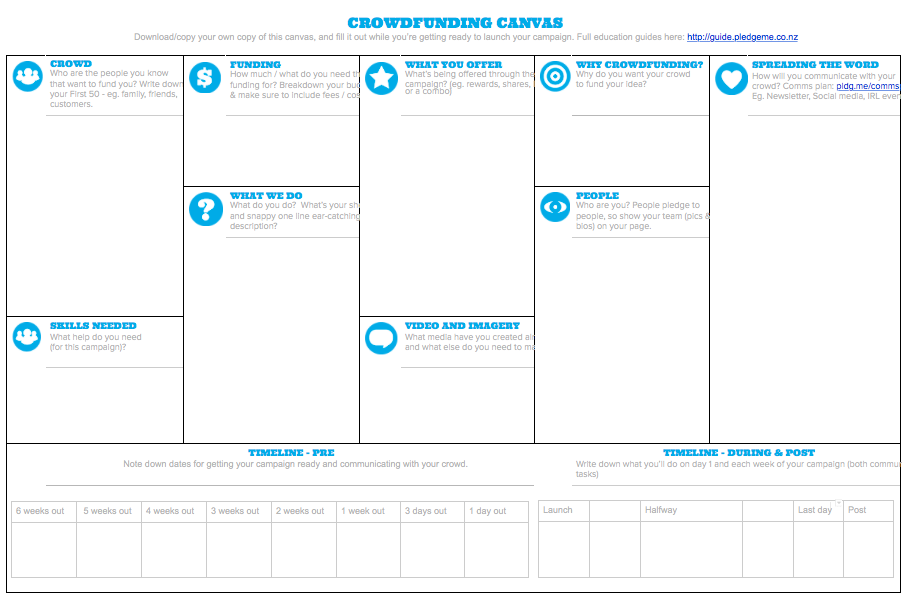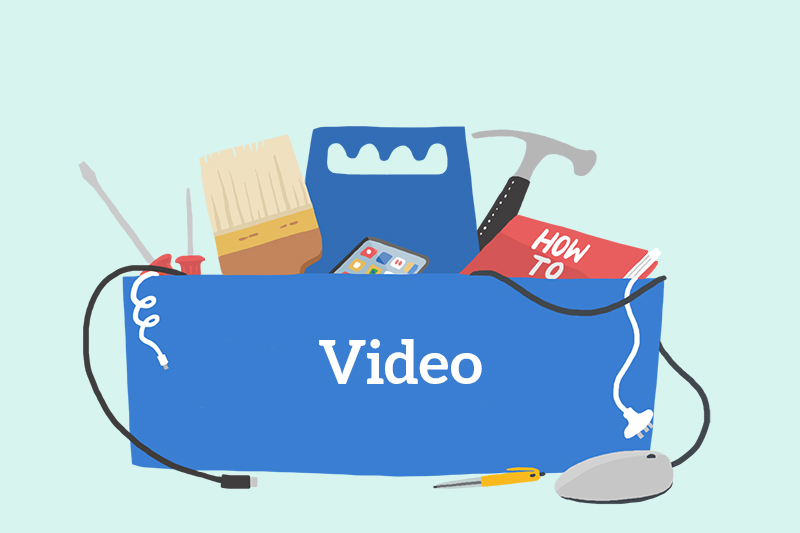One of the hardest things about every crowdfunding campaign is making it simple. Seeing everything you need to do on one page, and keeping track of where you are. Recently, we canvassed our crowd for ideas on how to make things easier and our friend Nat at Mum’s Garage came to the table with the idea of a canvas.
We’re big fans of the Lean Canvas here in the PledgeMe office, being regular mentors, judges, and attendees at Start Up Weekends around New Zealand. So, taking inspiration from that, and the Social Lean Canvas, we decided to create our own Crowdfunding Canvas.
Note: THIS IS NOT A BUSINESS PLAN! You should have your project and / or business plan stored somewhere else. This is just for your crowdfunding campaign (pre, during, and post).
Here’s how it works:
Step 1: Get the canvas

Go to the Crowdfunding Canvas and either:
- Create a Google Docs copy (File → Make a Copy), or
- Download the canvas (File → Download As).
You can print it out and hand write your plans on (small) post it notes / change as you go, or keep updating an online version.
Step 2: Fill out the canvas
Have a first run through of the canvas filling out each of the sections.
Left side: Your Crowd
-
Crowd
Write down the people who will pledge / share your campaign, and start chatting to them. These are actual humans you already know, not the crowd you’d like to support your project – a list of names, not general categories like students or animal lovers. Think about why they support you and how much you can reasonably expect them to be able to pledge.
-
Skills needed
Write down the skills you need, and think about whether anyone in your crowd above could help. Videographers, designers, writers, journos, social media whizzes, party planners – who do you know?
Middle section: Your Content
-
Funding
Note your overarching goal for the campaign (both min and max if you’re doing a lending or equity campaign) and make sure to include the costs for preparing and sending rewards (production, postage, etc) and PledgeMe’s fees. You should note what this money is for in one sentence. How does your budget compare to the pledging capability of your crowd? If you’ve got a shortfall, you’ll need to find a way to build a bigger crowd.
-
What we do
Write down in a sentence or two what you do. Where did your idea come from, why are you and your team the right people for the job, and why should your crowd get excited about it?
-
What you offer
Start drafting what you will offer your crowd: shares at what valuation, loan notes at what interest rate, or rewards. What will they get in return for pledging on your campaign?
-
Video and imagery
Start planning your visuals – note where you are at with your video (link to a script?) and where your best imagery is stored (of you, of what you do, and of your team).
-
Why crowdfunding?
Write down in a sentence or two why going to your crowd makes sense to you. It should probably be along the lines of “our crowd loves us, they matter to us and we want to keep them involved as we do our thing.”
-
People
Who are you? Write brief bios of each of your team, and be clear on what their role will be during the campaign (and beyond, if relevant). You can link to a bigger doc here if required.
Right side: How you communicate your content to your crowd
-
Spreading the word
Even if your crowd loves you, they can’t support your campaign if they don’t know about it. How are you going to get them involved? Phone calls, social media, direct emails, a newsletter, events, media coverage – what are you going to do, and who on your team will be responsible?
Bottom section: Your timeline
-
Timeline – Pre launch
One of the most common things we hear from campaign owners (both successful and not) is that they wish they’d spent more time planning. Most of the work behind a successful campaign takes place before it ever goes live. Prepping your crowd, nailing the budget, making a video, perfecting your rewards, reaching out to journalists, drafting a solid promotion plan – all essential to a smooth campaign. What do you need to have in place before you launch?
-
Timeline – During and Post launch
Even with a solid plan and your crowd’s interest piqued pre launch, you’re going to need time during the campaign to make it all happen. Getting the word out to your crowd via social media, direct emails, phone calls, campaign updates, and events can take up a lot of time. If your media plan goes well, someone will need to be on call to chat to journalists. After you close, organising and distributing rewards can be a full time gig. How will you and your team fit the campaign around your other responsibilities?
Step 3: Get feedback
Get feedback – this could be from your team, from us, or from your crowd! Are people excited about your rewards? Do they ‘get’ your vision? Does your budget sound reasonable? Would they pledge?
Step 4: Keep updating
Keep iterating and improving your canvas based on feedback and experience, both in the lead up to and during your campaign. If you’re getting similar questions from a lot of people, think about how to make your pitch clearer. If a reward is popular, ponder ways to offer more like it. Ditto for criticism – take it on board, integrate it if you need to, and thank people for their honest feedback. It’s better to hear this during the planning stage than when you’re in the midst of a busy campaign!






Hi, Do campaigners receive all their pledged funds regardless of whether they meet their goal or not?
Many thanks
Janet
Hi Janet
Thank you for your question! Campaigners only receive their funds (and pledgers only pay) if the campaign reaches its minimum goal.